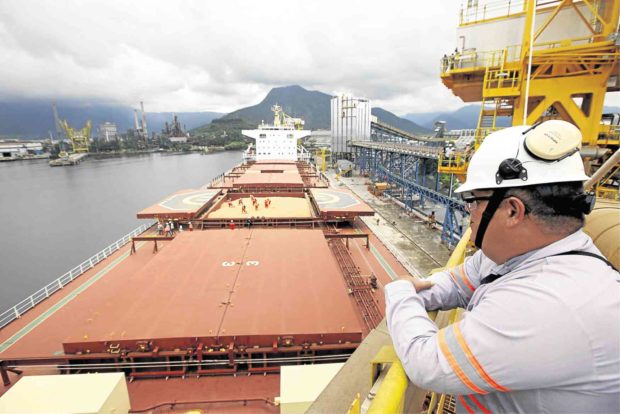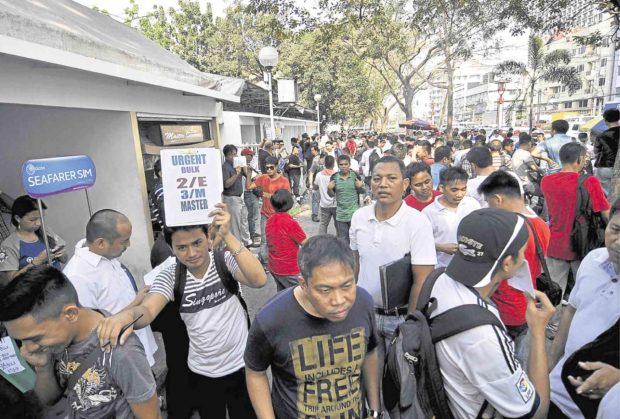PH seafarers need lifeline or sink amid global rivals

MUST STAY AFLOAT The head of the group United Filipino Seafarers says Filipino seamen have been losing their jobs to better-trained competitors from China, Russia and Vietnam, and that Philippine maritime training courses urgently need an upgrade. —Inquirer photos
The Philippines remains among the world’s top sources of seafarers, but its maritime industry is at an alarming ebb.
It now has many competitors—China, Russia and Vietnam among them—in producing seamen, said Nelson Ramirez, president of the United Filipino Seafarers (UFS). “Vietnam has three quality maritime universities, [with] 100,000 seamen already. Who will they replace? Filipinos,” he said:
“Chinese seafarers were the first to replace [Filipinos]. Their government really spends for them. Here in the Philippines, our government cannot do that and lets private institutions take over,” he added.
Data from the Philippine Overseas Employment Administration (POEA) show the steady decline in the number of Filipino seamen: 442,820 in 2016, 378,072 in 2017, and 330,859 by the end of 2018.
As many as 20,000-35,000 Filipinos complete a three-year maritime course in a year, but only around 5,000 manage to find jobs onboard ships, according to the Commission on Higher Education.
In fact, the Philippine maritime industry is “dying,” Ramirez said.
“This is why there are many training courses required for our seafarers: Our maritime education is wrong,” he said. “Some of the subjects in our current maritime curriculum are [misplaced]. Why not remove them and replace them with the courses that aspiring seafarers are required to take in maritime training centers after they graduate?”
Even fishermen
In Ramirez’s opinion, even fishermen—whom the POEA considers as seafarers, too—should be provided training programs on maritime matters.
He cited the June 9 Recto Bank incident in the West Philippine Sea, in which a Chinese trawler crashed into an anchored Filipino fishing boat and caused its sinking.
“To our fishermen, I would not tell you to go back to school and study nautical [matters],” Ramirez said. “But you there in Marina (Maritime Industry Authority), you should have programs for our fishermen that will give them knowledge in collision regulations, in rules of the road.”
Ramirez said that while there was yet no conclusion on the ramming and sinking of the FB Gem-Ver 1, it was clearly wrong for China’s Yuemaobinyu 42212 to abandon the Filipino crew in the open sea.
On July 6, a report on the joint investigation of the Marina and Philippine Coast Guard concluded that the Chinese vessel “failed to take appropriate action to avoid the risk of collision and to render assistance to a vessel in distress.” It said the Chinese crew members had “direct knowledge of the distress situation” as their vessel maneuvered back to about 50 meters from the stricken boat.
But instead of aiding the Filipinos, the Chinese vessel turned off its lights and sailed away, the report noted. The Filipinos were later rescued by a Vietnamese fishing boat.
The report added, however, that the Gem-Ver 1 had no proper lookout, that it was carrying persons in excess of the authorized capacity, and that whether its crew met the technical requirements of exhibited lights could not be determined.
Focused on minor issues
Ensuring maritime safety is one aspect in which the Marina is lacking, Ramirez said.
UFS has reported incidents of violations of maritime safety regulations, including ships sailing despite an excess in authorized capacity or without the proper lashing of rolling cargoes.
Part of an editorial in the UFS newspaper Tinig ng Marino read: “There was never any lack of rules regarding [maritime] safety [in the Philippines]. The real fault is the scarcity of political will to see those rules through.”
Ramirez said the Marina was deviating from its mandate to promote the economic viability of the maritime industry, and was focusing instead on its “minor” duties.
“Marina is concentrating on the issuance of the seamen’s book, documentation of seafarers, and others,” he said. “Marina is majoring in minor, minoring in major. Why does it concentrate on minor things? Where are the shipbuilding, drydocking and all that’s part of its mandate?”
Ruben Yeban, a seafarer for the past 24 years, also lamented the inconsistent costs of the training that seamen like himself were required to undergo in maritime centers.
“I hope the people in the government [will review] their regulations for seamen,” Yeban said. “Money is being milked from us and yet it takes us a long time before we can board a ship.”
An interview with the Marina did not materialize despite repeated appointments set and advance questions submitted by the Inquirer.
Exclusion from IMO list
The Marina has laid down a 10-year development plan that identifies the needs, goals and challenges of the maritime industry.
The plan includes the enhancement of maritime safety, strengthening of safety standards of Philippine-registered fishing vessels and the country’s development as a global maritime hub, among other flagship programs.
But Ramirez said the Marina was facing a more pressing issue today: the Philippines’ impending exclusion from the International Maritime Organization (IMO) White List. The IMO is affiliated with the United Nations.
A country’s inclusion on the White List means it complies with the minimum qualification standards for officers and personnel on seafaring merchant ships, under the IMO’s revised 1978 International Convention on Standards of Training, Certification and Watchkeeping for Seafarers (STCW).
The Philippines has been on the list since its first publication in 2000 and revisions in 2006 and 2011.

“As many as 20,000-35,000 Filipinos complete a 3-year maritime course in a year, but only around 5,000 manage to find jobs onboard ships”
Commission on Higher Education
If the Philippines is taken off the list, the 330,000 Filipino seafarers will temporarily lose their jobs, and all Marina-issued certificates will not be accredited by the IMO.
A rejected report is the simple reason for the Philippines’ looming exclusion.
The Marina insists that it filed its STCW compliance report in 2017 on time. The IMO confirmed receipt of the report but did not forward it to another committee because “the report did not respond to what was required of the convention.”
Then Marina Administrator Rey Leonardo Guerrero formed a team to review the rejected report and request an independent IMO evaluation of the Philippines in September.
$2.14B in remittances
Exclusion from the IMO list poses serious implications for a country whose economy heavily relies on seafarers’ remittances.
From January to April, Filipino seafarers sent home $2.14 billion, up 10.7 percent from $1.93 billion in the same four-month period in 2018, according to the party list group ACTS-OFW.
Seafarer remittances totaled $6.14 billion in the whole of 2018, up 4.5 percent from $5.87 billion in 2017.
More than nine-tenths of global trade is conducted at sea on some 100,000 merchant vessels with around 1.2 million seafarers, The Economist said. Of this number, over a quarter are Filipinos—the biggest sector by country of origin.
If the Philippine maritime industry is to be saved, seafarers should seriously take up maritime education, Ramirez said, adding: “Do not file frivolous cases [against ship owners] and do not be demanding [concerning wages].”
“Ambulance chasers” are another reason for the drop in the number of Filipino seafarers, said Ramirez, who is also an accredited maritime voluntary arbitrator.
He said that in the maritime scene, ambulance chasers included hospital agents who encourage injured seafarers to sue their companies, and lawyers who conspire with these agents.
These schemers assume they would win all legal cases, hence there is bribing among stakeholders, Ramirez said.
Hard life
But for Yeban, 56, seafaring is no walk in the park. “Life in the ship is hard—there is pressure in your work and people who are hard to deal with,” he said.
Newbie seafarer and father of four Gerald Botin said people usually had the wrong idea that seamen did easy work yet enjoyed large salaries.
Emerson Montilla, a 10-year veteran, echoed Botin’s sentiment: “You’re always away from your family …. Your salary may be high and you get to visit other places in the world for free, but sometimes, you can enjoy only a little of your life.”